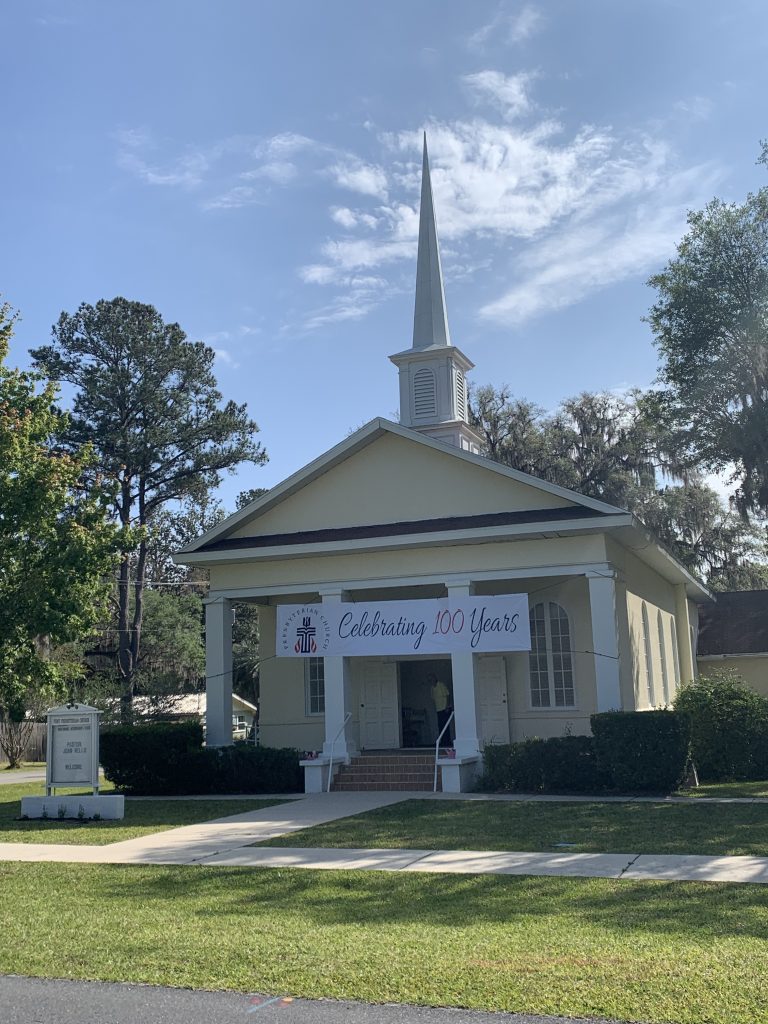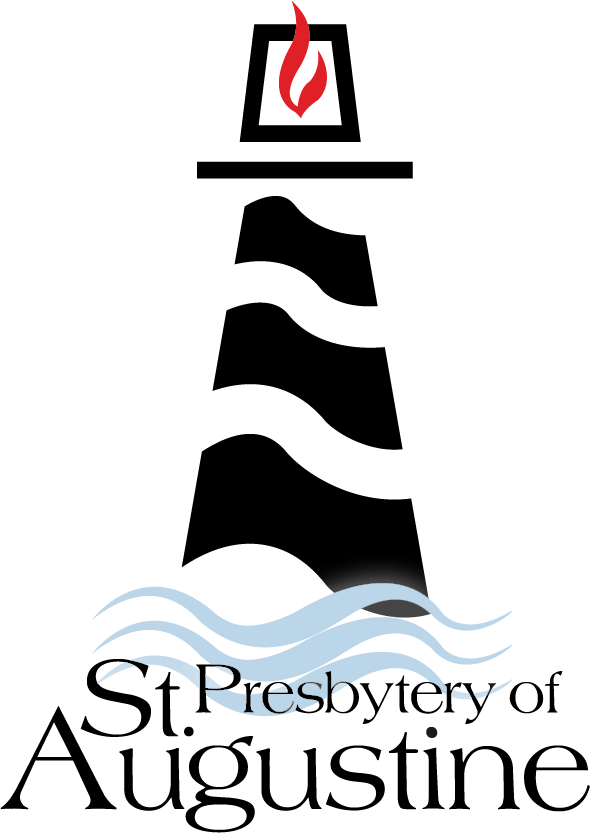Happy Centennial, Williston!
On April, 1, 2023, First Presbyterian Church of Williston celebrated 100 years! We are grateful for this milestone in the life of the church. Read about the history of the church below.

Ruby C. Ross had long been the Church historian. Her records are impeccable. Much of this article is based on her meticulous records. Later on, Ann Gay Burch continued to record ongoing Church history. Thanks to these ladies for all the time and labor they put into these records. Another special thanks goes to Bob Henry at the Williston Library, who was also a big contributor to these records.
Mrs. Ross began her presentation of “Our Presbyterian Heritage, by writing in detail about the Protestant Reformation, including such names and deeds/details as to what they did to accomplish our rich heritage. Martin Luther (Germany), John Wycliff (England), John Hus (Bohemia), John Calvin (France), and John Knox (Scotland), considered to be the father of the modern Presbyterian Church.
“Presbyterian” means “elder”. Therefore, Presbyterian churches are governed by the “ruling elders”, who are elected and ordained.
Many changes came about during the early Presbyterian Church, depending on numerous ideals and life situations. There were mergers and separations, followed by more mergers and separations, influenced by both internal and external forces. Generally speaking, the Presbyterian form of government, deacons and elders, replaced the Episcopal form of church government in England for a time, with the elimination of bishops and arch bishops. Depending on who was King, the Episcopal form was restored in England. Presbyterians, however, remained strong in Scotland, where the General Assembly of the Presbyterian Church resided, and adopted the form of government prepared by Westminster Assembly. Through migration and missionaries, their standards were spread throughout the world.
Calvinists (British Puritans and Pilgrims) and English, Scottish, and Scoth Irish Presbyterians were among the first settlers in Colonial America. Shortly thereafter, settlements came from Dutch Calvinists, French Huguenots, and German Reform. Most of these groups came over for religious freedom.
While the Founding Fathers were assembling the United States Constitution, the Presbyterians were organizing their American General Assembly, also in Philadelphia. 431 churches, 177 Presbyterian ministers, and almost 20,000 members.
With the coming of the American Civil War, many religious denominations split, following the states in which they resided. The Presbyterians followed suit, and organized the General Assembly of the Presbyterian Church in the Confederate States of America, in Augusta, Georgia. Several years after the War, the General Assemblies once again united.
PRESBYTERIANS COME TO WILLISTON
Fifteen Christians met with A. P. Gregory and I. E. Phillips, ministers representing the Suwannee Presbytery on April 1, 1923, to organize the First Presbyterian Church of Williston, the meeting took place at the Temple Theater building on Noble Avenue. (A second version of this was written in 1980 by person that was remembering the organization of the Church from her childhood. She indicated that they met in the Masonic Hall, which was located over the Ford Motor Garage.)
Reverend I. E. Phillips was called to serve as the first minister. His salary was “$500 per annum”. The first officers elected and installed were J. L. Ross (elder), William McDougald (deacon), and Pasley Brewer (deacon). Additionally, Mr. Harrison, Mr. & Mrs. E. C. Miller, Mr. Pasley, Hattie Peacock, J. L. Ross, Quincy P. Ross, Mrs. Joyce, Mr. & Mrs. Lacy Joyce, William McDougald, and Adlere Pasley were listed as charter members. At times, the Church was served by traveling ministers, who served four other local Presbyterian Churches.
Included in research are lists of 32 Deacons ordained between 1923 and 1972, another listing 12 more from 1973 to 1984, and 25 Ruling Elders ordained between 1923 and 1984 (including the first woman).
In 1957, neighboring Verbenadale and Morriston Presbyterian Churches closed. Many of these members were welcomed in as members to Williston
The Suwanee Presbytery gave financial assistance until 1968, when the Williston Church became financially independent. In 1984, the Church published a photo directory, while the Church continued to sponsor David and Mary Steel, as missionaries in Korea.
Homecoming: the first held on November 7, 1982. The Church was 59 years old. It had been served by 21 interim ministers and eight full-time pastors.
Eventually, our governing body switched from the Suwanee Presbytery to St. Augustine.
Several years later, Fifth Sundays became special. Several local Churched gather together every fifth Sunday. One Church hosted the group for a special evening service. Afterwards, the group retired to that Church’s fellowship hall, where women of the host church had prepared a pot luck; always tasty and enjoyable.
BUILDINGS, PROPERTY AND NEW TO THE CHURCH
The First Part of the Church Building: After two years of being “homeless”, these dedicated Presbyterians, with financial aid and guidance from the Presbytery, built the first part of the basic building on the corner of NE First Street and Third Avenue, in 1925.
The Addition of the Fellowship Hall and Remodeling of the Sanctuary: These began in 1947. The back wall was extended, adding a choir loft. The Fellowship Hall was then added, which was completed and dedicated in 1950, and named for Ruby Ross, Charter Member, Historian, and all-around Church woman.
The Steeple: The steeple had long been a hope of the Church, as early as the 1950 remodeling. Many members had contributed to a Memorial Fund, with the building of a steeple in mind. Many faithful members worked as a committee starting in 1975. They agreed that the approved proposed price fo a steeple would be $4,460.00. The money to complete the project would come from solicited pledges in an “Every Member Canvas”. If needed, the trustees were authorized to borrow up to $1,000.00. The steeple became a reality at 2:15 PM on Thursday, January 6, 1977, with a dedication service held on May 8, 1977.
The Choir and Choir Robes: Reverend McKay, the pastor during the late seventies, was a lover of good church music. He believed that the choir needed a beautiful choir. 17 members wore their new robes on June 26, 1977. The robes had been paid for mostly by private contributions, although some choir members paid for their own robes.
The Manse: (Roman Catholics call it a rectory) – Many New England Protestant churches call it a parsonage. All these titles simply mean is: living quarters, usually near or next to the Church with which it is associated. It houses the pastors and, if appropriate, their families. First Presbyterian built their manse in 1955. Dr. and Mrs. J. W. Creighton were the first occupants. They had been missionaries and were in the U.S. on leave. He served as Pastor until 1960, when he retired.
The Education Building: Also, Reverend McKay’s project. It was started and later enlarged in 1976. Many members staffed the Sunday School, which held four classrooms. Activities included Easter Egg hunts, Christmas parties, and caroling hay rides, in addition to traditional Sunday School lessons. Groundbreaking was held on October 13, 1947.
New Church Furnishings of Pulpit Furniture: This included communion table and chairs, pews, rostrum, and several other items given as memorials.
The Lot between NE First Street and State Road 121 across the street from the church building is also currently owned by the Church.
SPECIAL PROJECTS OF PAST AND PRESENT
Presbyterian Missionaries, Eckerd College (St. Petersburg, Fla.), Presbyterian School of Christian Education (Richmond, Va.), Columbia Seminary (Decatur, Ga.), Camp Montgomery Conference Center (Keystone Heights, Fla.), Ministerial Relief Fund, Montreat Conference Center (Blue Ridge Mountains), Rabun Gap-Nacooche School (Ga.), and Thernwell (Clinton, S.C.)
WOMEN IN THE CHURCH
Pastor’s wives are always special and provide much to the success of the Church. There were many through the years at our Church. The Presbyterian Auxiliary (Women of the Church) was formed in 1924. Their projects included the Foreign Missions Offering, the Home Missions Offering and the Ministerial Relief Offering.
In more modern times, it was known as the Presbyterian Women, which met once a month (except for July/August). A short prayer, and a business meeting was followed by a lesson. Some years, a book prepared by the Presbytery was used. Someone different presided over the meeting each month. Presbyterian Women had some of the same projects as their earlier counterparts and many others. Many of these projects were focused on local issues. Food band, Christmas presents for those confined to long-term care facilities, Christmas Caroling, etc. Unfortunately, COVID ended this several years back.
It was still a man’s world into the 1980’s. Women, generally, were not part of a governing body in many churches. These was especially true with Presbyterians. (It’s still true in one particular branch of the Presbyterian Church.) But, a woman whose Church service was beyond reproach broke into the man’s world of Williston Presbyterian in January 8, 1984. Mrs. F. W. (Rosa Mae) Priest was elected and ordained the first woman Elder. Rosa Mae had been born into a Presbyterian family. She had been a member of the Morriston Church until it closed. She served in many capacities over the years: teaching Sunday School, holding offices in Presbyterian Women organizations, Church pianist, and directing Bible Study. She was the Mother of a rather large family. Her late son Danny had been a deacon and an elder, and another son, Haile, is currently and elder. She gave us much by which we can remember her.
Ruby Ross, as mentioned earlier, Ruby was a mover and shaker in the idea and construction of the Fellowship Hall.
Betty O’Neill (Mrs. William), modern day contemporary who provided a great deal of value to a variety of needs. She, along with Mrs. Priest, were the first women on the Pulpit Committee.
